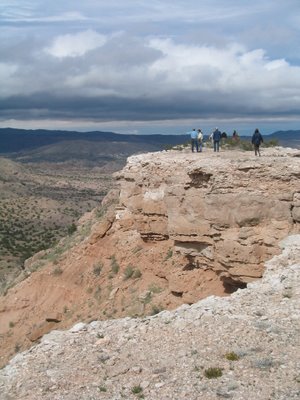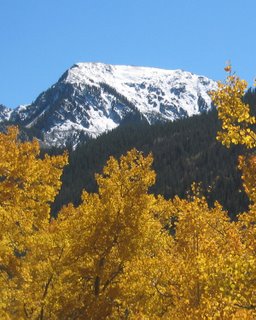I recently encountered two artifacts. One was scary, the other wasn’t.
The first was
Pulse, a Japanese horror film I’d rented thinking it was science fiction. The plot involved ghosts who were using the Internet to communicate, to creep people out, and eventually to transform them into more ghosts. It was basically
Ringu, with the Internet substituting for videotape and telephones substituting for, well, telephones.
Despite the reuse of the Ringu formula, the low budget, and the obligatory scene in which the protagonists have to do something bone stupid in order to put themselves in jeopardy, the film was well directed and acted. Special effects were inexpensive but effective. And the final scenes, with the protagonists wandering around an empty Tokyo inhabited only by ghosts, had a poignancy that you generally don’t see in horror.
What the movie wasn’t was scary. There were some genuinely eerie moments, sure, and some disturbing visuals, but I don’t think my heart rate went up at any point.
If you have a couple hours to waste, those hours can be wasted with
Pulse. It will do no harm. Just don’t expect to experience a fight-or-fly reflex at any point.
The genuinely scary experience came with listening to the audio book of Robert Kurston’s
Shadow Divers. Which was surprising, because the book is nonfiction, about a group of East Coast scuba divers who discover a sunken U-Boat off New Jersey, who learn that there is no record of it being there, and who then go to extremes to learn its identity.
The wreck of the sub is at 230 feet, in very cold water swept by unpredictable currents. This puts it in very dangerous territory indeed, well outside the more shallow, tropical sport dives I’ve dived personally. (In fact I have told Kathy that if she ever hears me making plans to do a wreck dive at that depth, she has my permission to break both my knees.)
During the course of the narrative one diver drowns on the wreck. Two others, father and son, make uncontrolled ascents and die excruciating deaths from the bends. Another uncontrolled ascent shoots the diver out of the water like a Polaris missile, but he survives after some time in a decompression chamber. John Chatterton, one of the book’s protagonists, is caught on debris, pinned by wreckage, and runs out of air while on the wreck, but somehow survives..
When I was listening to this my heart began to race and my palms turned sweaty. I was scared to death.
Few die on scuba from just one cause. There’s usually a cascade of events, often beginning with something simple.
Shadow Divers describes how one diver dies on the
Andrea Doria because he reaches for his knife with his left hand instead of his right. This begins a catastrophic series of events that ends with the panicked, seriously narked diver wildly slashing at his friends with that same knife, then disappearing into the wreck to drown.
If he’d reached with his right hand, he would have been all right.
That one really got my pulse up. Chills ran right up my spine.
I don’t think I found the book scary just because I’m a diver. It probably helped that I could visualize a lot of what was going on, but the technical aspects of diving are very well described in the book, including the “hammer of narcosis” that requires deep divers breathing air to execute highly complex acts while, basically, raving drunk and with tunnel vision.
I imagine any reader would be subject to the chills when the author simply walks you through the sequence of events leading to the death of a human being, starting with the seemingly innocent act of reaching for the knife with the left hand.
So now I wonder why the artifact that was intended to scare me didn’t, and the one that was written as a factual account had me in near-terror.
Before proceeding I should confess my biases. I seem to be horror-deaf. The works of Stephen King leave me unmoved. I admire the classical structure of a Lovecraft story, but am untouched by fear of Cthulhu. I’m not afraid of werewolves or vampires.
What scares me is what
real human beings do to
other real human beings.
If I were in Hell, I’d be a lot more scared of my fellow inmates than of my demonic jailers.
I think that vampires and werewolves are things that human beings imagine because it’s more bearable than imagining the sort of thing their neighbors might be getting up to.
So perhaps it’s not surprising that I find nonfiction scarier than a horror film.
But still, it seems to me if you want to scare the wits out of your reader, a few concrete rules apply.
Details Matter. It’s scary when horror intrudes on the world you know, and that world is made up of concrete details. Even though Stephen King doesn’t ring my personal chimes, he did a useful thing when he moved horror away from the isolated old mansions, haunted graveyards, and eccentric aesthetes of Lovecraft and into the American suburbia of tract homes, Snoopy dolls, and mac and cheese. It’s a setting familiar not just to Americans, but (through the miracle of television) to audiences worldwide. It’s the world of
Father Knows Best with a tentacle slipping past the door— and it’s the Snoopy doll and the macaroni and cheese that make the world real. (And besides, the macaroni and cheese may give an extra thrill of horror to a French audience.)
Decisions Matter. One reason I lost interest in
Pulse is that nothing the characters did really counted. They were either going to get eaten by the ghosts or they weren’t. Whether they survived or not was entirely a matter of luck.
While this is a defensible existential position, it doesn’t make for interesting fiction. It should matter whether the diver reaches with the left hand or the right. And even then— even if he reaches with the wrong hand— there are still options that will allow him to correct his situation. The cascade of terrible events can be interrupted, though perhaps at each subsequent point with greater and greater effort.
The lesson is that the
horror must not be inevitable. If it’s inevitable it may be tragedy— it may even be real life— but it’s not particularly scary. The horror is in watching the cascade start, the dominoes toppling one by one, and knowing that they could be stopped if only someone knew how.
Suspense Matters. Alfred Hitchcock, who ought to know if anyone did, illustrated the difference between shock and suspense thus: Suppose you’re watching a movie, and a couple old fellows are sitting on a bus talking about football, and then the bus blows up. That’s shock. It lasts a second or two, and then it's over.
Now in contrast suppose that you show someone planting the bomb under the seat of the bus. And then the old duffers sit down and start talking about football. And you cut from the duffers to the bomb and back. That is going to be the
most suspenseful football discussion you’ve ever heard. (And Hitchcock did in fact put that scene in
Saboteur, his adaptation of Joseph Conrad’s
The Secret Agent, which Hitchcock couldn’t call
The Secret Agent because he’d already used the title for his adaptation of Somerset Maugham’s
Ashenden.)
Suspense and its close cousin, terror, depend on careful control of information. In order to be scared, the audience has to be told what the scary thing is, and how it operates, and why they should care. If you write, “the diver reached for his knife with his left hand, and then he died,” the reader isn’t going to be able to make the connection, and isn’t going to give a damn. Explain how the dive gear works, and how using the left hand started that fatal cascade, and you’ve got your audience in the palm of your hand.
Let The Horror Grow In Its Own Time. Say you’re watching a home movie. A couple children are deliberately skidding their bikes in the oil that’s been freshly applied to a dusty street. It’s suburbia: the sun is shining, the lawns are green, the kids are carefree.
This movie is not scary.
Now it’s twenty years later. It’s revealed that the kids grew up in
Times Beach, Missouri. The oil was poisoned with dioxin and PCBs. The kid is grown up and is waiting in the doctor’s office for the results of his biopsy.
Scared yet? I am. I got chills just thinking of that illustration.
The moral is: horror creeps. Possibly on little cat feet, possibly on tentacles, but it creeps. It’s a miasm, an atmosphere. It builds.
Let it build.
Let’s all be scary. It’s Halloween.
Boo.

